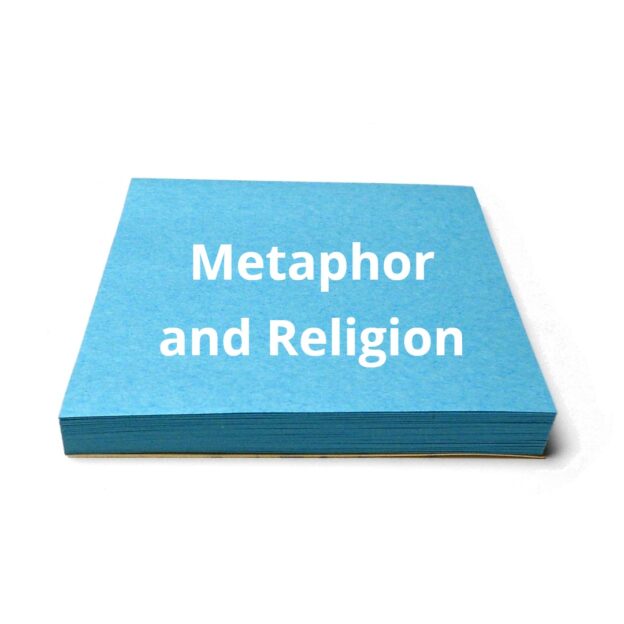by Paul-François Tremlett
In the late 19th century, as the sheer diversity of religions dawned on nascent traditions of enquiry in the social sciences and the humanities, a number of scholars sought to define Religion by establishing the key common traits and features they assumed would be shared by all of the different religions. This project generated new research which, while certainly adding to the sum total of human knowledge about religions, nevertheless did not deliver on the promise of a definition of Religion, or at least not a universal one that could boast any consensus outside usage by particular interest groups.
In the early twenty-first century, the standard approach to Religion (still with a capital R) is somewhat different. Instead of trying to delineate a distinct class of religious facts we approach Religion through metaphor. Think of “liquid religion” or “vernacular religion”. These metaphors, both popular in today’s academic circles, tell us not what Religion is, but rather invite us to attend to certain qualities of Religion that chime with our wider contemporary experience. “Liquid”, as Zygmunt Bauman said, means “change is the only permanence, and uncertainty the only certainty”, and the new mobilities and flows enabled by globalization and digital media have seen both new forms of Religion (from place-based congregations to digitally-enabled global communities such as El Shaddai) and new kinds of Religion influenced by popular culture and new technologies, such as Terasem. “Vernacular religion”, with its connotations of local variation and performance as well as perhaps dissenting departure from official norms, invites us to imagine Religion not as something abstract or grandiose but rather as something put to work in ordinary life. It is a metaphor with enormous resonance in cultures that celebrate the individual as a source of its own authority and in societies keen to celebrate local authenticities and eccentricities against imaginaries of bloated institutions and zombie bureaucracies. Thinking about Religion through these and other metaphors is, in my view, productive and a welcome alternative to the collection of facts and the formulation of typologies that defined Religious Studies in decades past and, in this short post I want to road-test an alternative metaphor for Religion: “sticky”.
There are at least three iterations of “sticky religion”. The first comes from the functionalist school in twentieth century Sociology which regarded the performance of religious rituals as sticky occasions because of their capacity to cement or glue different societal elements together. Emile Durkheim’s classic The Elementary Forms of the Religious Life (first translated into English in 1915) is regarded by many as a foundational expression of this point of view.
The second comes from feminist and post-colonial theory but shares certain affinities with the first. Sara Ahmed’s interest in emotion and affect and her exploration of the ways in which emotions move and come to bind bodies, objects and places together, extends Durkheim’s insight as to the mucilaginous qualities of certain social practices. For example, according to Ahmed, words become sticky through the various resonances and associations that they gather through time and through use. If we apply her insights to Religion, it is clear that it is a word that has accumulated many layers of meaning and significance, both emotional and intellectual, largely without anyone being particularly aware of the when, why or how, and those meanings cannot easily be unstuck or separated.
The third comes from contemporary cognitive anthropologists such as Pascal Boyer and Dan Sperber, who regard religious beliefs as side-effects of ordinary thinking. In their view, human brains are pre-wired to anticipate reality. That is, humans arrive into the world with a pre-programmed set of expectations about how the world works: a solid object can’t pass through another solid object (everyday physics), animals without wings can’t fly (everyday biology) and I will never know what’s going on inside my reader’s mind (everyday psychology). Religious beliefs break all of these hard-wired assumptions about reality: ghosts walk through walls, mythical horses fly, and gods are privy to every human thought. But if religious beliefs contravene our expectations of reality – expectations which in other circumstances our lives depend on – why do people believe them? Why do these beliefs persist when they deliver false expectations? According to our cognitive anthropologists, people believe them because they are sticky, first activating and then bonding with, other cognitive capacities associated with social life.
“Sticky religion” offers a way of thinking that draws attention to certain qualities or aspects of Religion. It neither offers to explain nor understand Religion. Instead it positions it in a fragile and shifting web of connections.
References
Ahmed, S. 2014, The Cultural Politics of Emotion (2nd Ed), Edinburgh: University of Edinburgh Press.
Bauman, Z. 2000, Liquid Modernity, Cambridge: Polity.
Boyer, P. 2000, Religion Explained: The Evolutionary Origins of Religious Thought, New York: Basic Books.
Durkheim, E. 1915, The Elementary Forms of the Religious Life, (trans). J. W. Swain, London: Allen and Unwin.
Sperber, D. 1996, Explaining Culture: A Naturalistic Approach, Oxford: Blackwell.

